Take Charge of Your Dog's Feeding Routine
By Michele Welton, Dog Trainer, Breed Selection Consultant, Author of 15 Dog Books
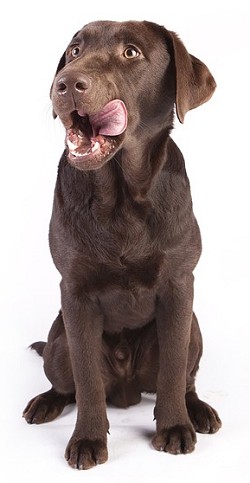
At feeding time, don't just casually toss your dog's bowl on the floor. Instead, use this excellent opportunity for building that solid leader-follow relationship you should have with your dog.
One of the best ways to establish a good leader-follower relationship with your dog is by controlling the resources in his life.
Resources are things your pup views as important, such as food, toys, sleeping spots, even petting and belly rubs.
Most dogs view FOOD as the most important resource. So when you show your pup that you're in charge of the food, you're making the gentle but clear statement that you are the leader and he is the follower.
Your dog finds this very reassuring.
How do you show him that you're in charge of the food? As with most leadership techniques, it's simply a matter of establishing the right routine that your pup can count on.
First, how often should you feed your dog?
Most pups over 8 weeks old should eat three meals per day until 4 months old, then two meals per day thereafter.
Toy breed puppies (because they can have problems regulating their blood sugar) should eat four meals per day until 4 months old, then three meals per day until 6 months old, then two meals per day thereafter.
Adult dogs should eat twice a day unless they have health problems that require more meals.
Dogs who eat only once a day may experience an empty stomach, may even spit up white froth/bile. Think of how our own stomachs growl, and how we often feel irritable, when we've gone too long without eating.
Now, WHAT to feed your dog is a more complicated question that I address in my many feeding articles. Maybe start here.
A good mealtime routine
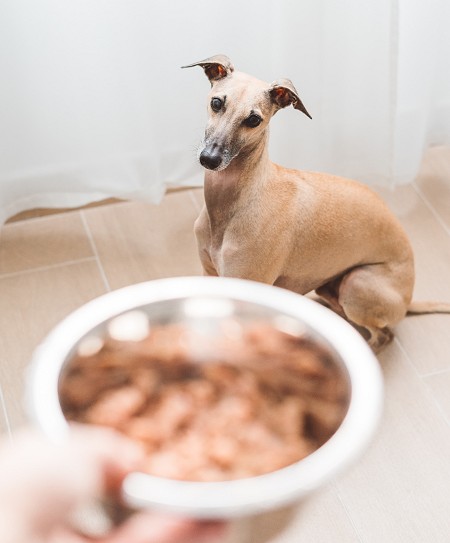
Structured routines always make dogs feel secure because they can predict what's going to happen next. Uncertainty = stress. In case you're curious, this dog is a Whippet.
- Cue your pup when you're ready to prepare his meal. "Are you hungry? Want your food?" Emphasize the key words.
- Have him come with you to the kitchen. Get his bowl from the same cupboard and set it on the same counter every time. He should be right there watching you. You want him to see that YOU are the source of his food.
- If he's acting excitable, don't put his food down, else he'll learn that excitable behavior makes the food appear! If he's racing around, barking, or jumping, he should be on leash so you can stop those behaviors.
- When he is calm, the bowl is ready to go down. If he already knows how to sit, have him sit first – another subtle and gentle leadership thing. Then.... "Okay!" and place the bowl on the floor, in the same spot every time. "Here's your food."
- If you have multiple dogs, each should have his own eating spot away from the others. Place the bowls down in the same order each time, saying the dog's name as his bowl goes down. "Buffy... here's your food. Mouse... food. Jenna... food."
- During mealtime, leaders protect followers. Don't let kids or other pets approach a dog who is eating. If one of your dogs is not well-behaved enough to obey this rule, he should be dragging his leash so you can get hold of him. If necessary, feed the dogs in separate crates or separate rooms. Stealing food is completely unacceptable.
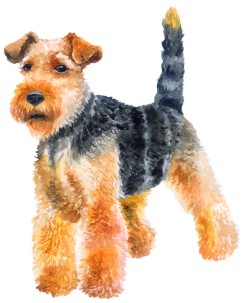 If a pup walks away from his bowl, pick it up; if there is still food left, make a mental or written note to monitor for any other symptoms that might suggest illness. After 10 minutes, all bowls, finished or not, should be picked up to avoid picky behavior or food guarding.
If a pup walks away from his bowl, pick it up; if there is still food left, make a mental or written note to monitor for any other symptoms that might suggest illness. After 10 minutes, all bowls, finished or not, should be picked up to avoid picky behavior or food guarding.- The final part of the routine is a potty break immediately after every meal. Announce the potty break: "Do you need to go OUT? Time to go OUT."
Remember: the easiest way to raise and train your dog is to establish choreographed routines – same things, same order, same words – with yourself as the director, the one in charge. Create good routines, stick to them, and your pup's behavior will be predictable and good.
No scheduled mealtimes? You leave kibble down all day?
Oops, that's not a good idea. You shouldn't even leave food down for an hour, let alone all day.
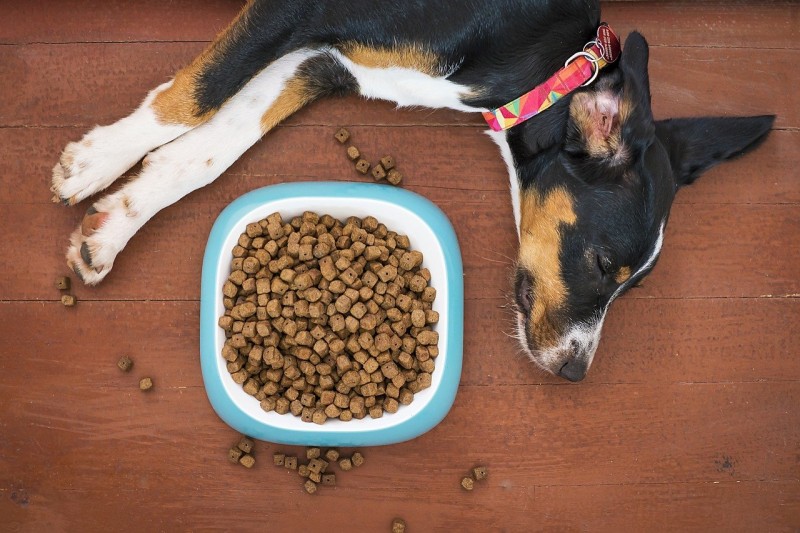
Here are 5 reasons "free feeding" is not a good idea:
- Free feeding can create picky eaters who feel entitled to food rather than appreciative of being given food.
- Free feeding makes your pup's digestive cycle unpredictable, which means you don't know when he will need to go to the bathroom.
- Your pup's appetite is a good barometer of his health, and it's easier to keep tabs on appetite when you're offering scheduled meals and watching him eat.
- If you have more than one dog, free feeding invites bullying and can create food guarding issues.
- Finally, as you've seen in this chapter, scheduled feeding is a prime opportunity to demonstrate that you are in charge of the food. You make the food appear, you require your pup to be calm and polite before you give it to him, you allow a certain amount of time for eating, then you pick up the bowl.
Scheduled, controlled feeding reinforces the proper leader-follower relationship, whereas "free feeding" gives your pup the impression that food is always magically available.
Should you ever pick up your pup's food bowl while he's eating, to teach him that you can take his food away?
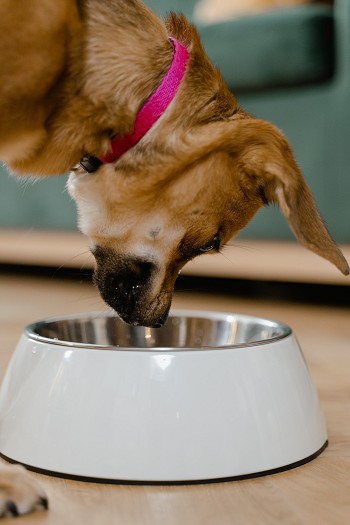
On this issue, my fellow trainers are divided.
Some say, "Yes, you should teach your pup that you can take his food away. Someday you might need to do that to keep him safe."
Others say, "Taking your pup's bowl away can cause anxiety and food guarding. Let him eat in peace."
I see merits in both views, so I do something in-between.
When I have a new dog, I do accustom him to having my hand near his bowl. I do this by walking past him while he's eating and casually dropping something extra-yummy (chicken or cheese) into his bowl. I say, "Good food" as I do so. I only do this a couple of times per week.
If the above goes well, then at some point while he's eating, I say, "Want some food?" and I pick up the bowl he's eating from. I only raise it a foot or two off the floor and I make sure he sees me add a yummy treat to the bowl. "Good food," I say as I give the bowl back. This routine I will do only once per month.
This positive technique turns the removal of his food bowl into a good thing. Then if you should need to take it completely away, it's more likely that he won't react negatively. Of course I can't guarantee that!
If your dog is already guarding his food
If you approach your pup while he's eating and he...
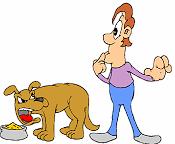 stops eating and stares fixedly at you
stops eating and stares fixedly at you- or drops his head close to his bowl and starts eating faster
- or braces his front legs on either side of the bowl as though claiming it
- or maneuvers his body so it's between you and his bowl, making it more difficult for you to reach
- or curls his lip or growls
...you have a problem. It's called resource guarding and it's a potentially dangerous behavior issue.
What should you do? Well, judgment is required here.
If your pup is large or if he has already snapped at (or bitten) someone, you should call a local balanced trainer who can evaluate the situation personally. If the pup is smallish and has never actually snapped at (or bitten) anyone, you might decide to try working with him on your own.
The good news is that some resource guarding will stop simply by establishing the right leader-follower relationship.
Immediately begin working through all my training articles and put each one into practice in your household. For example, a resource-guarding dog should not be allowed on your bed or furniture. He should not be allowed to demand petting. Give only one toy, but take even that away if he makes any attempt to guard it. And so on.
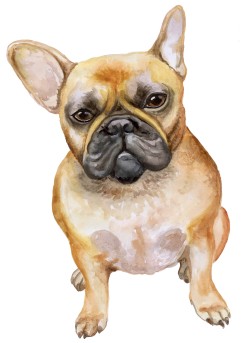 Feed a resource guarder in his crate. Put the food in first, then move well away from the crate and send the pup in. When he's done, call the pup out and make sure he's well away from the crate before you remove the bowl.
Feed a resource guarder in his crate. Put the food in first, then move well away from the crate and send the pup in. When he's done, call the pup out and make sure he's well away from the crate before you remove the bowl.
Always think safety.
Alternatively, you can completely change the way you feed the pup. Put his bowl away. Mix his food in a different bowl, sit in a chair, and hold that bowl in your lap. Feed him by offering one small scoop at a time from a long-handled spoon. Before each bite, have him Sit or Lie down or do a trick or any other word that he knows. In other words, he must work for his food.
If you do all that but see no improvement, I strongly urge you to find a local balanced trainer who can (safely) teach the pup to move away from the bowl when told to.
This is a serious issue. Many dogs get dropped off at shelters or rescue groups or offered free to good home because they're resource guarders. Many biting dogs started out as resource guarders of food or toys or sleeping spots. Some dogs even view their owner's lap as a resource to be guarded against all comers (animal or human).
I would not allow a child around a dog who is a resource guarder. At least not in the presence of any food or toys.
My best-selling books – now available FREE on my website
 Respect Training For Puppies: 30 seconds to a calm, polite, well-behaved puppy is for puppies 2 to 18 months old. Your puppy will learn the 21 skills that all family dogs need to know. Click here to read for free.
Respect Training For Puppies: 30 seconds to a calm, polite, well-behaved puppy is for puppies 2 to 18 months old. Your puppy will learn the 21 skills that all family dogs need to know. Click here to read for free. Teach Your Dog 100 English Words is a unique Vocabulary and Respect Training Program that will teach your adult dog to listen to you and do what you say. Click here to read for free.
Teach Your Dog 100 English Words is a unique Vocabulary and Respect Training Program that will teach your adult dog to listen to you and do what you say. Click here to read for free. 11 Things You Must Do Right To Keep Your Dog Healthy and Happy helps your dog live a longer, healthier life. Get my honest advice about all 11 Things before you bring home your new puppy, because some mistakes with early health care cannot be undone. Click here to read for free.
11 Things You Must Do Right To Keep Your Dog Healthy and Happy helps your dog live a longer, healthier life. Get my honest advice about all 11 Things before you bring home your new puppy, because some mistakes with early health care cannot be undone. Click here to read for free.
